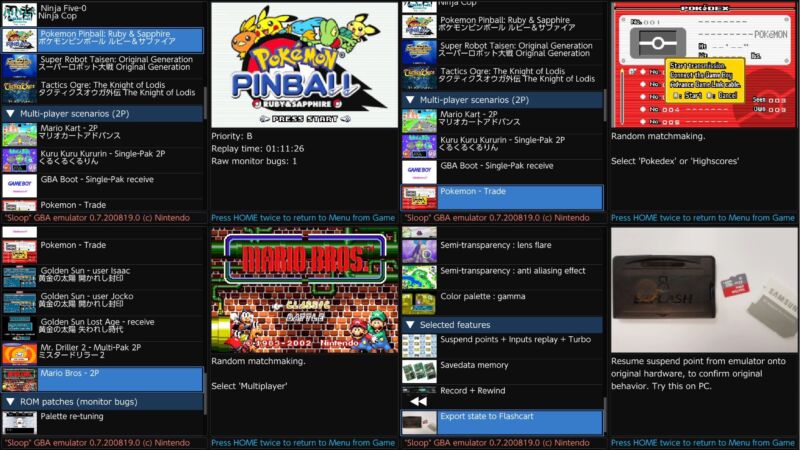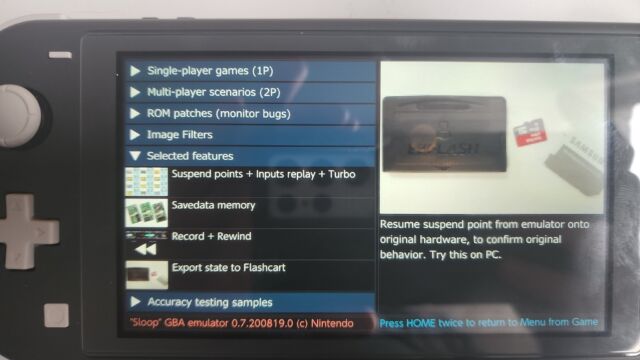
In most cases, the release of yet another classic console emulator for the Switch wouldn’t be all that noteworthy. But experts tell Ars that a pair of Game Boy and Game Boy Advance emulators for the Switch that leaked online Monday show signs of being official products of Nintendo’s European Research & Development division (NERD). That has some industry watchers hopeful that Nintendo may be planning official support for some emulated classic portable games through the Nintendo Switch Online subscription service in the future.
What’s in the leak?
The two leaked emulators—codenamed Hiroko for Game Boy and Sloop for Game Boy Advance—first hit the Internet as fully compiled NSP files and encrypted NCA files linked from a 4chan thread posted to the Pokemon board Monday afternoon. Later in that thread, the original poster suggested that these emulators “are official in-house development versions of Game Boy Color/Advance emulators for Nintendo Switch Online, which have not been announced or released.”
In short order, dataminers examining the package found a .git folder in the ROM. That folder includes commit logs that reference supposed development work circa August 2020 from a NERD employee and, strangely enough, a developer at Panasonic Vietnam.
NERD’s history includes work on the software for the NES Classic and SNES Classic, as well as the GameCube emulation technology in last year’s Super Mario All-Stars, so the division’s supposed involvement wouldn’t be out of the ordinary. Footage from the leaked Game Boy Advance emulator also includes a “(c) Nintendo” and “(c) 2019 – 2020 Nintendo” at various points.
While suggestive, none of this is exactly hard evidence of Nintendo’s involvement in making these emulators. Some skepticism might be warranted, too, because there is some historical precedent for an emulator developer trying to get more attention by pretending their homebrew product is a “leaked” official Nintendo release.

Some observers also pointed to other reasons to doubt that these leaks were an “official” Nintendo work product. ModernVintageGamer and others noted that the leaked GBA emulator includes an “export state to Flashcart” option designed “to confirm original behavior” on “original hardware,” according to the GUI. That option is illustrated with a picture of an EZFlash third-party flash cartridge in the emulator interface, an odd choice given Nintendo’s previous litigious attacks on such flashcart makers.
A “savedata memory” option in the emulator also references the ability to “inter-operate with flashcarts, other emulators, [and] fan websites…” That’s a list that would serve as a decent Johnny Carson “Carnac the Magnificent” setup for “things Nintendo wouldn’t want to reference in an official product.”
“I’m absolutely convinced of its legitimacy”
So, did these emulators actually come from Nintendo or is it all an elaborate hoax? Nintendo hasn’t responded to a request for comment, so we consulted with a video game historian who has been actively involved in tracking, cataloging, and preserving Nintendo prototypes through various online communities for years. While that source asked to remain anonymous to avoid any potential blowback from Nintendo, they said they were “99.9% sure [the emulators are] real” and that “personally I’m absolutely convinced of its legitimacy.”
The strongest evidence of Nintendo’s involvement with these emulators, our source said, was the security signature on the NSP files. That signature ensures the NSPs can only run on development hardware “due to prototypes being signed with different keys than retail games are,” our source said. Someone trying to install the emulator files on a hacked retail Switch “will just run into errors and it won’t boot.”
It’s theoretically possible that a homebrew developer with access to Switch development hardware could dummy up a signed file like this. But our source said that it is “extremely hard to fake a dev signed NSP. Only those with a good understanding and access to the SDK would know how to.” Doing so would also require “many many hours [spent] learning how to use the extensive SDK,” our source said. That kind of intimate SDK knowledge “isn’t really a focus at all for most [homebrew] developers on the Switch,” who focus on other tools to make software for hacked retail units, they added. https://arstechnica.com/?p=1849079

